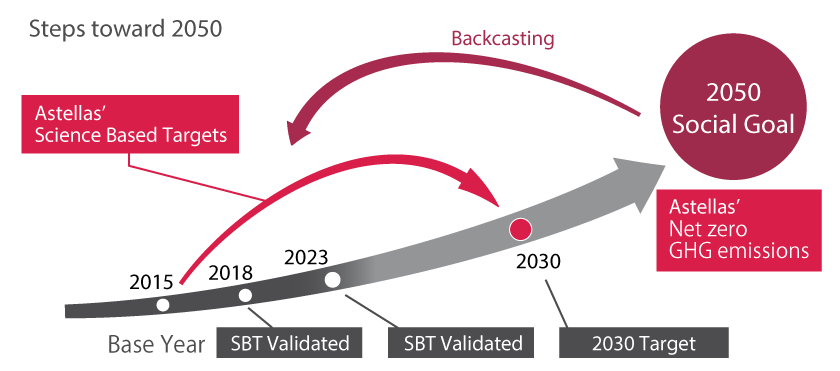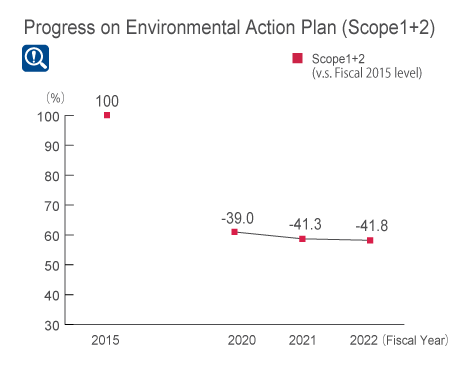Mitigating and adapting to the threat posed by climate change requires active involvement by national governments, local governments, corporations, citizens, and others. Astellas recognizes that climate change will become a constraint on conducting sustained corporate activity, and considers it an important management issue to address.
Astellas has made a long-term commitment to taking measures against climate change and decided to aim for achieving a 90% reduction in GHG emissions and a 10% neutralization of residual emissions to achieve Net Zero by 2050, based on 2015, for Scope 1 and 2 and Scope 3, respectively. In addition, the Science Based Targets (SBT) initiative approved Astellas’ GHG emissions reduction targets through 2030.
To address climate change as a management issue, we have adopted as targets, the 1.5℃ (Scope 1 and 2) and well-below 2℃ (Scope 3) targets of the Paris Climate Agreement.
Environmental Action Plan (Climate Change Mitigation Measures) (SBT re-certified in January 2023)
Reduce GHG emissions (Scope 1 + Scope 2) by 63% by fiscal 2030 (Base year: fiscal 2015)
(Emissions in the base year: 202 kilotons) [1.5℃ target]
Reduce GHG emissions (Scope 3) by 37.5% by fiscal 2030
(Base year: fiscal 2015) [well-below 2℃ target]
Progress on the new Action Plan (SBT)
Our results calculated based on the GHG Protocol are as follows:
Progress on Environmental Action Plan (Scope 3)
| Fiscal 2015 | Fiscal 2020 | Fiscal 2021 | Fiscal 2022 | |
| GHG emissions (Scope 3) (Tons) | 453,173 | 268,113 | 312,998 | 445,007 |
| Ratio to Base-year (%) | -- | -40.8 | -30.9 | -1.8 |
Scope 3 Category 2 data was re-calculated because the former calculation method had been applied partially. Please refer to the following link "Indirect GHG emissions (Scope 3)".
indirect GHG emissions (Scope 3)
evaluation of the former action plan
Changes in Actual GHG Emissions Volume
The actual volume of GHG emissions of Astellas in fiscal 2022 was 118 kilotons (Scope 1: 61 kilotons, Scope 2: 56 kilotons).
Changes in Actual GHG Emissions Volume by Area
| Fiscal 2015 | Ratio (%) |
Fiscal 2020 | Ratio (%) |
Fiscal 2021 | Ratio (%) |
Fiscal 2022 |
Ratio (%) |
|
| Japan | 166,857 | 75 | 94,522 | 77 | 89,725 | 76 | 89,709 | 76 |
| Scope 1 | 61,036 | 46,217 | 46,662 | 44,253 | ||||
| Scope 2 | 105,821 | 48,305 | 43,063 | 45,456 | ||||
| US | 31,185 | 14 | 13,880 | 11 | 12,448 | 10 | 12,673 | 11 |
| Scope 1 | 20,742 | 7,139 | 5,686 | 6,418 | ||||
| Scope 2 | 10,443 | 6,741 | 6,762 | 6,256 | ||||
| Established Markets | 16,725 | 8 | 8,601 | 7 | 9,913 | 8 | 8,917 | 8 |
| Scope 1 | 13,073 | 7,799 | 9,115 | 8,324 | ||||
| Scope 2 | 3,652 | 802 | 798 | 593 | ||||
| Greater China | 3,349 | 2 | 3,623 | 3 | 3,956 | 3 | 3,697 | 3 |
| Scope 1 | 14 | 29 | 47 | 29 | ||||
| Scope 2 | 3,335 | 3,594 | 3,909 | 3,668 | ||||
| International Markets | 4,628 | 2 | 2,695 | 2 | 2,636 | 2 | 2,647 | 2 |
| Scope 1 | 3,635 | 2,092 | 2,181 | 2,147 | ||||
| Scope 2 | 994 | 603 | 455 | 499 | ||||
| Total | 222,744 | - | 123,320 | - | 118,679 | - | 117,644 | - |
| Scope 1 | 98,500 | 63,276 | 63,691 | 61,171 | ||||
| Scope 2 | 124,244 | 60,044 | 54,988 | 56,473 |
Non-energy GHG emissions are less than 5% of total emissions and therefore not included in the disclosed data.
Our Efforts to Reduce GHG Emissions
In order to reduce GHG emissions, Astellas must implement management practices that involve the entire Group from a medium-term perspective. Astellas’ manufacturing plants, research centers, sales and marketing divisions, and offices are implementing a variety of initiatives with the aim of mitigating climate change.
Regarding tangible elements, efforts to improve facilities, which include the introduction of high-efficiency equipment and the conversion to alternative fuels, are expected to make a significant contribution to reducing the level of GHG emissions generated by energy sources. Regarding intangible aspects, employees’ participation in energy saving through improvements of daily work is also important. To this end, each facility adopts a two-pronged approach, comprising measures related to both tangible and intangible elements.
Investment Plan for Climate Change Mitigation Measures
In fiscal 2022, Astellas planned to invest approximately ¥900 million in mainly energy-saving measures at each business facility, the renewal of air conditioning equipment, and the introduction of LED lighting. An investment of ¥600 million was actually completed, resulting in reduction of 5,236 tons of GHG.
Astellas will keep on conducting continuous reviews of investment plans related to matters such as introducing renewable energy.
Understanding GHG Emissions in the Supply Chain
Although the Environmental Action Plan concerning climate change is targeting emissions directly generated by business activities (Scope 1 and Scope 2), Astellas is also striving to assess emissions produced throughout the entire supply chain (Scope 3). We have also set SBTs for GHG emissions from major categories within Scope 3, and are striving to reduce them. In addition, we encourage support and cooperation with our measures to reduce GHG emissions, including transactions among our production contractors
Details of Scope 3 are available in the section on indirect GHG emissions (Scope 3).
Indirect GHG emissions (Scope 3)
Priority Use of Gaseous Fuel
At Astellas’ research and production bases, we use boilers fueled by city gas, LPG and LNG (liquefied natural gas), all of which generate low GHG emissions during combustion. These boilers not only contribute to reducing GHG emissions but also to reducing SOx emissions, another air pollutant.
Introduction of Energy Monitoring Systems
Knowing exactly how much energy we use is useful for the formulation of new strategies. We have introduced energy monitoring systems that can visually monitor energy usage at our facilities.
Reduction of GHG Emissions Generated by Sales Activities
Since fiscal 2008, Astellas has been striving to reduce GHG emissions associated with the use of sales fleets. In each region, we are continuously switching over to vehicles with low environmental impact (e.g., hybrid cars, electric vehicles). In Japan and the US, where the rate of introducing hybrid vehicles is high, the volume of GHG emissions relative to the number of vehicles has been reduced more than in other regions.
GHG emissions associated with the use of sales fleets are reported under Scope 1.
Changes in GHG Emissions Volume
| Fiscal 2020 | Fiscal 2021 | Fiscal 2022 |
|
| Total emissions | 12,980 | 12,697 | 12,378 |
When it cannot be directly measured, CO2 emissions are estimated based on fuel purchase costs, annual average fuel usage by company vehicles or private vehicles (if used in sales activities) and other factors. Figures do not include data from Asia/Oceania region (with partial exception).
Incorporating Sustainability Indicators into Executive's Incentive-based Renumeration
Starting from the 19th term business year (fiscal 2023), Astellas has incorporated a new key performance indicator by setting sustainability performance targets for bonus (short-term incentive remuneration) for Directors who are not the Audit & Supervisory Committee Members (and excluding Outside Directors). By linking management strategies with incentive compensation, Astellas aims to steadily promote environmental initiatives.
For details of remuneration for Directors, please refer to page 70 of the Notice of Convocation of the 18th Term Annual Shareholders Meeting.
Convocation of the 18th Term Annual Shareholders Meeting
Using Renewable Energy
The use of renewable energy is one of the most effective climate change countermeasures. Astellas is introducing photovoltaic panels and wind power generation, and such equipment as biomass boilers, and purchases electricity derived from renewable energy sources to reduce GHG emissions. We will continue to strive expanding the use of renewable energies to help achieve Net Zero.
Usage of renewable energy
| Fiscal 2015 | Fiscal 2020 | Fiscal 2021 | Fiscal 2022 |
|
| Total energy used (TJ) | 3,010 | 2,087 | 2,089 | 2,048 |
| Energy derived from renewable energy sources (TJ) | 342 | 397 | 392 | 387 |
| Renewable energy rate (%) | 11 | 19 | 19 | 19 |
| Total electricity (GWh) | 279 | 228 | 226 | 227 |
| Electricity derived from renewable energy sources (GWh) | 48 | 97 | 98 | 95 |
| Renewable energy rate (%) | 17 | 43 | 43 | 42 |
* From the disclosure of fiscal 2022 results, the amount of energy consumed by the use of purchased electricity and electricity generated internally using renewable energy sources (solar power, wind power, etc.) is converted at 3.6 MJ per 1 kWh.
Starting in April 2020, Astellas switched all electricity consumed by its three research and production sites in Japan (Tsukuba Research Center, Tsukuba Biotechnology Research Center and Takahagi Chemistry & Technology Development Center) to hydroelectric power(*), which is free of GHG emissions. This enabled a reduction of emissions of 29,300 tons. Moreover, we are also moving ahead on switching to electricity generated by renewable energy sources in areas outside of Japan.
Looking ahead, Astellas will continue to explore opportunities for using renewable energy, and it will also consider formulating targets for the use of renewable energy.
(*) The Aqua Premium plan provided by TEPCO Energy Partner, Inc.
Participation in the Federation of Economic Organizations’ Carbon Neutrality Action Plan
Astellas is participating in the Carbon Neutrality Action Plan* formulated by the Federation of Pharmaceutical Manufacturers’ Associations of Japan, which is based on requests from the Federation of Economic Organizations. In February 2023, Astellas committed to a policy of reducing GHG emissions from operations to Net Zero by 2050.
* With a long-term vision of Net Zero CO2 emissions by 2050, the Phase II target (2030 target) is to reduce CO2 emissions in fiscal 2030 by 46% (from laboratories, plants, offices and vehicles used in sales) from the fiscal 2013 level.



